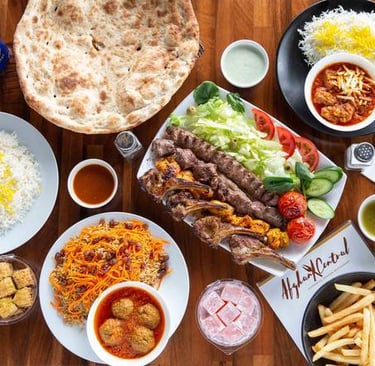Cuisine and Dining Etiquette
Cuisine and Dining Etiquette Afghan cuisine is largely based on the country’s traditional staples, such as wheat, maize, barley, and rice, along with its native fruits and vegetables.
CULTURE


Korma is a stew or casserole, usually served with chalau, or parboiled white rice that is then baked with butter or oil and salt. Mantu is a meat-stuffed dumpling topped with yogurt that takes its flavor cues from Chinese and Central Asian cuisines. Aushak is leek-filled pasta dumplings with a meaty tomato sauce topped with yogurt and dried mint. Kabobs also feature prominently in Afghan cuisine. They are most often found in restaurants and outdoor vendor stalls. Kofta consists of balls of minced or ground meat — usually beef or lamb — mixed with spices and onions. Soups made of a variety of items, such as vegetables, noodles, beans, yogurt, and ground meat, are very popular in Afghanistan.
These soups are locally known as shorma. Afghan bread, Naan-e Afghani, is the national bread of Afghanistan. The bread is oval or rectangular and baked in a tandoor, a cylindrical oven that is the primary cooking equipment of the sub-continental region.Bread is a staple of the Afghan diet and is served with most meals, or is even a meal itself among poorer Afghans. Diners share a loaf (or loaves) of bread, pulling off pieces to use to scoop up food from a plate or bowl and transfer it to their mouths. Afghanistan produces many high-quality fruits, including grapes, apricots, plums, and other stone fruits, pomegranates, melons, and berries, along with some varieties of oranges. Fresh, dried, and pickled or canned fruits are an important component of Afghan fare. Several nuts, including walnuts, almonds, pistachios, and pine nuts are also very popular in the country.338 Raisins and nuts are served at just about every meeting or gathering. Afghanistan, like most regions of the world, has its own unique tea culture. Black or green chai (tea) is the most popular drink in Afghanistan. It is customary for hosts and hostesses, personal and professional, to serve tea to their guests. The availability of safe drinking water remains a challenge in Afghanistan, and one needs to be careful consuming local water. It is best for foreigners to drink bottled water. One should also avoid anything with ice, as it may have been made from the tap water. Fresh fruits and vegetables, including salads, may be washed in tap or well water, so one needs to be careful consuming these foods as well.
There are many differences between Afghan and Western dining etiquette. Westerners generally dine seated on chairs at tables, are served individual meals or portions (although some Western meals are served buffet or family style), and use cutlery and other utensils for serving and eating. Afghans, at least in family and social situations, often eat seated in a circle on large colorful cushions called toshak. Food is served on cloth, plastic, or vinyl tablecloths (disterkhan) spread on the floor or carpet. Afghan food is generally served communally with everyone sharing from the same dish.339 Afghans usually do not use cutlery. Since food is often eaten directly with the hands, cleanliness is extremely important. A bowl or basin is often provided for hand washing, just prior to meals. The left hand should be used as little as possible and is not to be used in a communal bowl. Food is taken with the right hand, but both hands can be used to eat once food is taken from the communal bowl.
Food should be taken only from the portion of the communal plate directly in front of you. Food is usually scooped up into a ball at the tip of the fingers, or with naan (Afghan bread) used as a scoop, and then eaten. When guests are present in Afghan homes, males eat separately and typically prior to females and children.
Source: ANALYSIS OF AN INTERVENTION.
